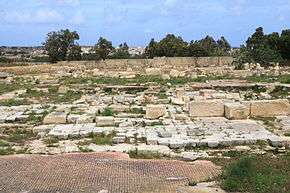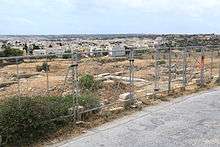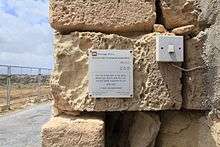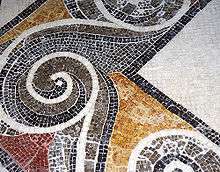Tas-Silġ
 Ruins of Tas-Silġ | |
 Shown within Malta | |
| Location | Marsaxlokk, Malta |
|---|---|
| Coordinates | 35°50′45.3″N 14°33′7.5″E / 35.845917°N 14.552083°ECoordinates: 35°50′45.3″N 14°33′7.5″E / 35.845917°N 14.552083°E |
| Type |
Temple Village Monastery Fortification |
| Part of | Megalithic Temples of Malta |
| History | |
| Material | Limestone |
| Founded | c. 2500 BC |
| Abandoned | c. 870 AD |
| Periods |
Tarxien phase Bronze Age Phoenician Roman Byzantine |
| Site notes | |
| Excavation dates |
1963–1970 1996–2005 |
| Condition | Ruins |
| Ownership | Government of Malta |
| Management | Heritage Malta |
| Public access | By appointment |
Tas-Silġ is a rounded hilltop overlooking Marsaxlokk Bay, Malta, close to the city of Żejtun.[1] Tas-Silġ is a multi-period sanctuary site covering all eras from Neolithic to the fourth century AD, and due to this it indicates to archaeologists several different layers of excavation.[2] The site takes its name from the nearby Church of Our Lady of the Snows (Maltese: Knisja tal-Madonna tas-Silġ).[3]


Megalithic Temple and Bronze Age settlement
The area was first inhabited when a temple was built in the Tarxien phase of Maltese prehistory, sometime around 3000 to 2500 BC. Few remains from the original temple can be seen, but the scatter of megaliths over the hill suggests that there was a large complex with at least 3 temples and possibly a village surrounding it. A D-shaped setting of large blocks that was part of the four-apsed temple still exists as it was later incorporated into the other buildings on the site. In the Bronze Age, the temple was probably converted into a settlement, as had been done in other sites such as Borġ in-Nadur.
In the deepest layer of deposits, archaeologists found various artifacts including pottery, lithics, and a standing fat lady.[1] From the Bronze Age layer, some sherds, stone tools and pottery were found. Other evidence from the Bronze Age consists of the large amount of handiwork.[2]
Punic, Hellenistic and Roman temple
After the Phoenicians took over Malta in around 700 BC, they built a Punic temple to Astarte incorporating upstanding remains of the earlier temple. A forward extension was added to the curved facade, and a monumental doorway flanked with two pilasters and topped by a huge stone slab was built. The sanctuary's importance eventually grew and a portico was added around 300 BC. Some parts of the temple, including a tower, might have been designed as a fortification to help defend it from possible invaders.
A threshold slab pierced by three libation holes that divided the eastern part of the temple and the western side, as well as a series of ashlar foundation walls for a platform built to the south of the main sanctuary still exist. Around this area, various remains were found including pottery, ash, animal bones, coins and shreds. Some of these shreds have votive inscriptions. It is claimed that the Cippi of Melqart might have originally been at the Tas-Silġ temple, but their origin is disputed.
In the Roman era, the Punic temple was converted into a sanctuary of Juno, which was the Roman equivalent to Astarte. In 70 BC, Cicero mentioned the temple in his In Verrem, in which he said that the temple was revered by everyone including pirates and Numidian princes, but the Roman Governor of Sicily had stolen some of its treasures. Some Roman material was discovered in various deposits around a well in the lower terrace of Tas-Silġ.[2][3]
Large water storage areas under Tas-Silġ were recently found and mapped, and they probably date to the Punic or Roman eras.[4]
Byzantine monastery
Later on, in the 4th or 5th centuries AD, a Byzantine monastery were built over the remains of the previous temples. The church had a central nave separated from the aisles by two rows of columns, and a small baptismal font was constructed in what was originally the megalithic temple. Some remains of sculpture were found, including a worn female marble head and an ivory capital with a hanging palmette. Pottery from this period was also found, including amphorae and locally made plates and other items.[3]
During the Byzantine period, it may be that the fat lady was deliberately defaced and buried in a hollow.[1]
In the 8th century, defensive walls were hastily built around the monastery at Tas-Silġ.[5]
The monastery was abandoned soon after the Arabs occupied Malta in 870 AD. The site was turned into a quarry and stones from the original structure were removed. In the medieval period farms were built on the area, and rubble walls from this era still exist. The whole site was buried under a metre of soil before being excavated.[6]
Modern history

In the 17th century writers began to speculate the location of Juno's temple that was referred to in ancient texts, however the site was only discovered in the 20th century. It was included on the Antiquities List of 1925.[7]
A remain of a column from the temple at tas-Silg, built in the Phoenician period, is today found at the 17th-century Palazzo Marnisi in Marsaxlokk.[8]
An Italian Mission led the first excavations in between 1963 and 1972 and identified the sanctuary.[1] From 1996 to 2005 the University of Malta and an Italian team started another excavation project to clean other layers of sediments. The site is shielded by a cover to protect it from further erosion.[2]
Heritage Malta runs the conservation of Tas-Silġ but has unfortunately been closed to public up to now, although it may be visited by appointment. Despite this, efforts to conserve the site so one day it will be open to the public began to be made as of September 2013.[9]
References
- 1 2 3 4 Trump, David H. (2004). Malta: Prehistory and Temples. Misdea Book Ltd. pp. 138, 139.
- 1 2 3 4 "Tas-Silġ Excavation Project (1996–2005)". University of Malta. Archived from the original on 29 November 2014.
- 1 2 3 "Tas-Silg Sanctuary". oneweekholiday.com. Archived from the original on 6 June 2014.
- ↑ "Exploring the deep". Times of Malta. 24 June 2012. Archived from the original on 11 January 2016.
- ↑ Spiteri, Stephen C. (2004–2007). "The 'Castellu di la Chitati' the medieval castle of the walled town of Mdina" (PDF). Arx – Online Journal of Military Architecture and Fortification (1–4): 4. Archived from the original (PDF) on November 15, 2015. Retrieved 15 November 2015.
- ↑ "Tas-Silg – A Living Memory Of Cultures which effected Maltese And European History". Malta Info Guide. Archived from the original on 12 July 2015.
- ↑ "Protection of Antiquities Regulations 21st November, 1932 Government Notice 402 of 1932, as Amended by Government Notices 127 of 1935 and 338 of 1939.". Malta Environment and Planning Authority. Archived from the original on 20 April 2016.
- ↑ Bonello, Vincenzo (1964). Missione archeologica italiana a Malta: Rapporto preliminare della campagna 1963. Missione archeologica italiana a Malta. Centro di studi semitici, Istituto di studi del Vicino Oriente, Università. p. 42.
- ↑ Carabott, Sarah (24 September 2013). "Tas-Silġ... uncovered". Times of Malta. Archived from the original on 12 January 2016.
External links
| Wikimedia Commons has media related to Tas-Silġ Temples. |
